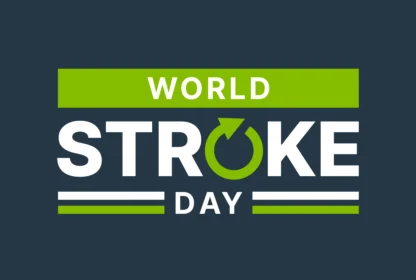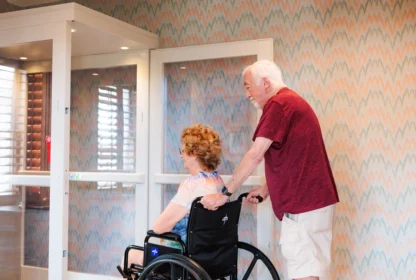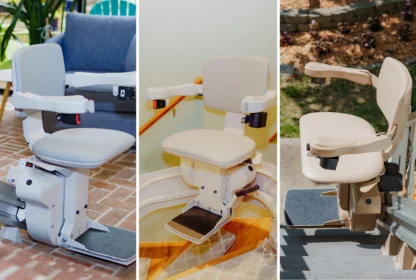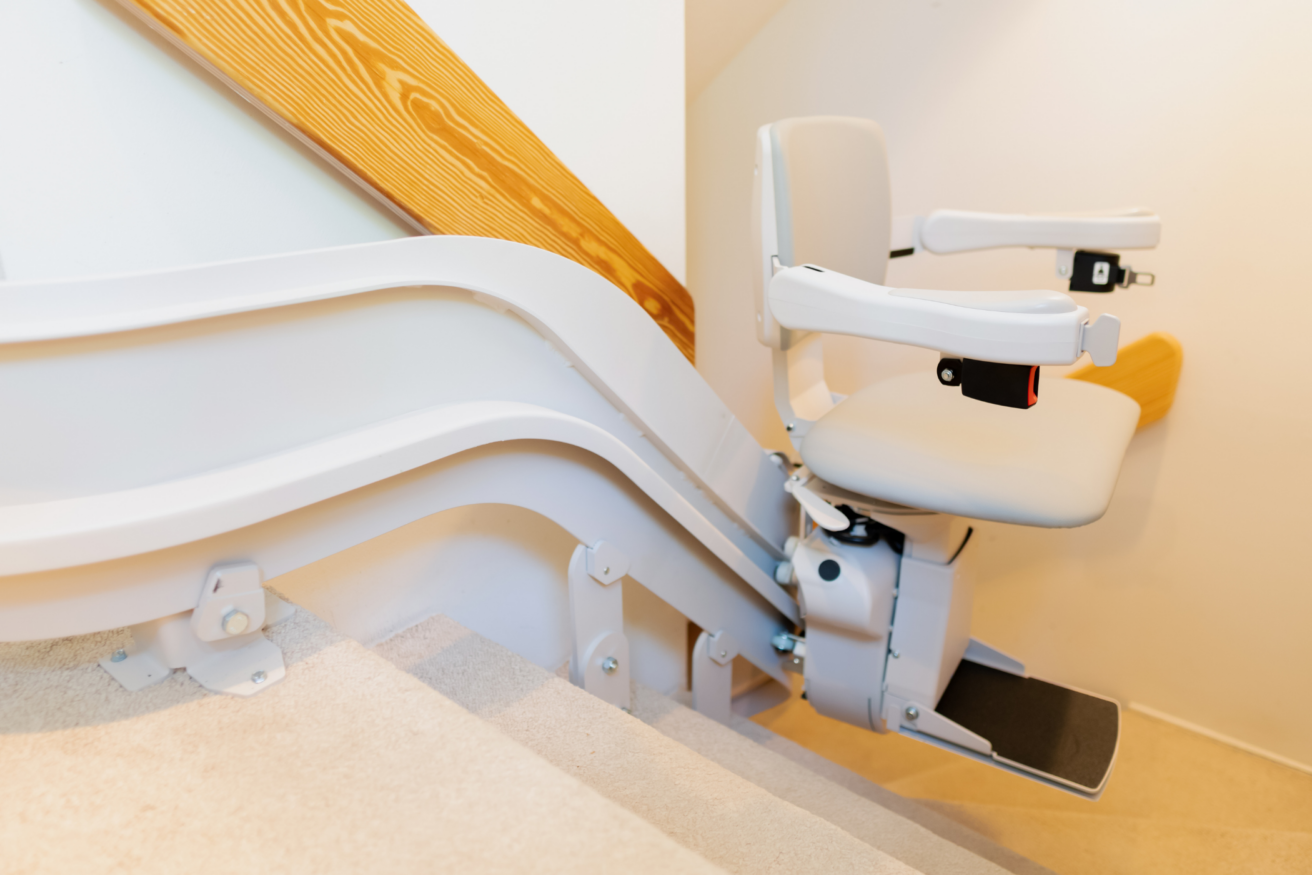
“My husband has knee problems, and he’s having trouble getting up and down the stairs in our home. It’s painful for him, and I’m worried that he might hurt himself. My friend has a stairlift and we are interested in getting one, but we aren’t sure what we need or where to buy one. Can you help us?”
At 101 Mobility, we receive questions like this daily. We understand that the loss of mobility and the ability to easily climb the stairs in your home can come as a shock. It can seem like once easy chores, like carrying the laundry up the stairs, suddenly become difficult and even dangerous. If you are having trouble with your stairs and are seeking solutions that don’t involve giving up the home that you love to move to a single-story alternative, a stair lift can be a great option. We’ve put together the following information to help guide you through the process and ensure that you get the best stairlift for your needs.
What’s it called?
While everyone can agree that stairlifts are useful tools to help individuals safely get up and down the stairs, nobody seems to be able to agree on what to call them. We’ve heard the following terms, among others: stair chair, chair lift, stair glide, stair lifter, and “that thing that goes up the stairs”. While an industry expert will know what you are looking for, regardless of the term you use, it may be helpful to know that the most commonly accepted name is “Stairlift”.
How does it work?
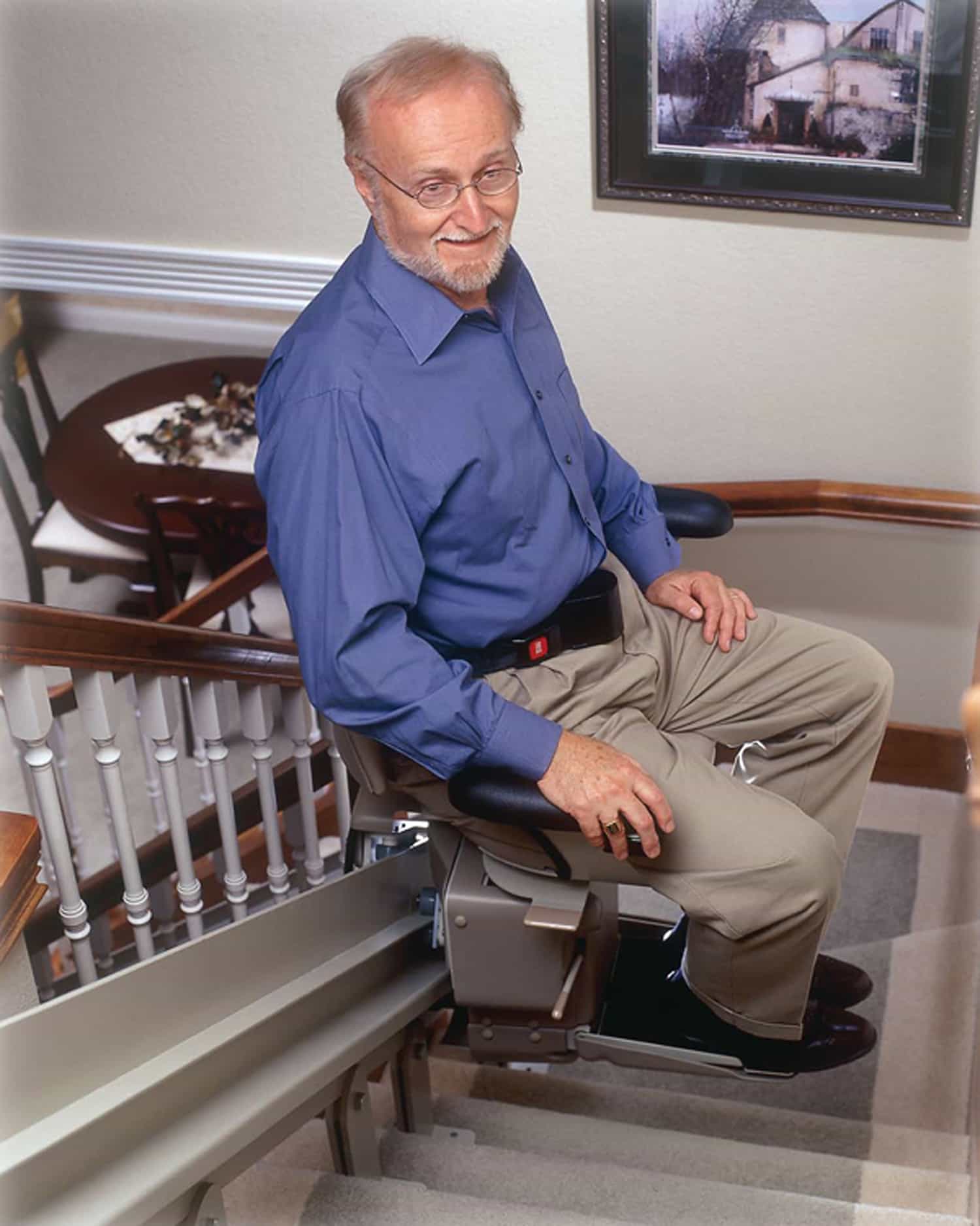
It is important to note that stairlifts mount directly into your staircase, not the wall. This makes them extra sturdy, while also ensuring that they are compatible with nearly any staircase, regardless of whether it has walls or banisters on either side. The chair runs along a railing, which is attached to your staircase with a mount on every few steps, depending on how steep your staircase is. Your stairlift will need to be plugged in – it requires a standard wall outlet, the same as you would plug a lamp into, within 6 feet of the top or bottom of the staircase (depending on the model).
What if I lose power?
Most stairlifts are equipped with a backup battery – if you live in an area that is prone to power outages, be sure to request a unit with a backup battery! Depending on the model of stair lift, the battery may charge anywhere along the rail, or in a designated position at the top or bottom. As long as the chair is in the proper position, the unit will charge anytime it is not in use. In the case of a power outage, a fully charged unit will continue to run for anywhere from 40-60 round trips (that’s up AND down the stairs) before needing to be charged again.
My staircase is complicated – will a stair lift fit?
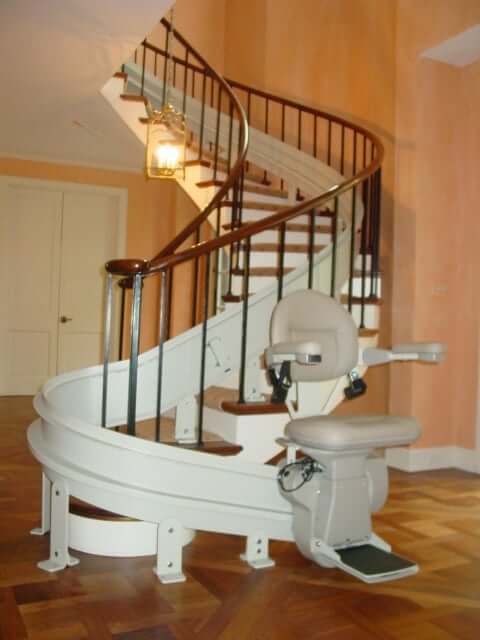 Bruno Elite Custom Curved Stairlift
Bruno Elite Custom Curved Stairlift
For the large majority of households, the answer is yes! There are two main types of stairlifts: straight rail, and custom curved rail. The straight rail variations are perfect for stairs that don’t have any turns, curves, or landings along the way. They typically cost between about $3,000 and $5,000, and can often be installed within a few days because they do not require customization.
Custom curved stair lifts are suitable for nearly any other stair case, whether you have a split level house, a curved stair case, or a number of other configurations. Due to the uniqueness of curved staircases, these stairlifts are custom-made. Typically, a Product Specialist will come to your home to take photographs of the staircase using a special 3-D camera. The images are then sent to the manufacturer to fabricate your custom railing. Because the process is more complex, these stair lifts typically cost between about $10,000 and $15,000, sometimes more, depending on your specific staircase. The custom manufacturing process also takes longer, so it typically takes about three to four weeks from the time when the photographs are taken to the time when the unit can be installed.
Read More: Stair Lift Cost: A Complete Guide for Consumers
My staircase is outside… are they weather-proof?
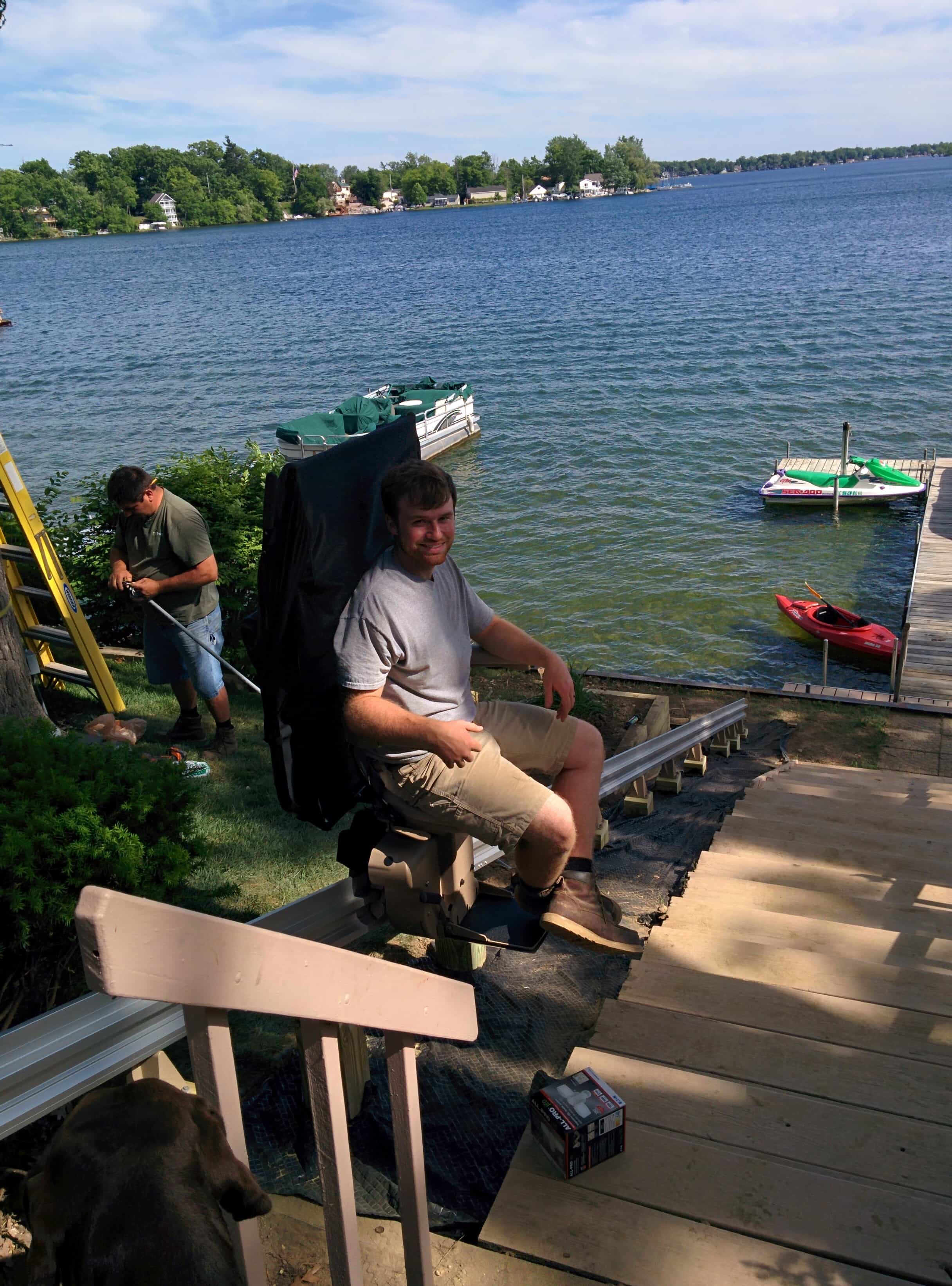 Bruno Outdoor Stairlift
Bruno Outdoor Stairlift
Yes! There are outdoor versions of both straight and custom stairlifts available. The outdoor units are weatherproof and typically come with a seat cover so you don’t have to worry about the seat getting wet or dirty when not in use. They are specifically made to withstand UV light, rain, and even freezing temperatures. Outdoor stairlifts are typically a little more expensive than their indoor counterparts. They are great options when you don’t have the space required for a ramp.
What is the weight capacity?
Most standard units have a weight capacity of around 300 lbs. However, there are many options available with weight capacities between 400 and 600 lbs. If the end-user is close to or above 300 lbs, or if the user plans on carrying heavy items like groceries with them on the stair lift, be sure to ask about units with higher weight capacities. In addition to a higher weight capacity, heavy-duty lifts often come with wider seats to ensure a comfortable ride.
Will the stairlift get in the way when I try to walk up the stairs?
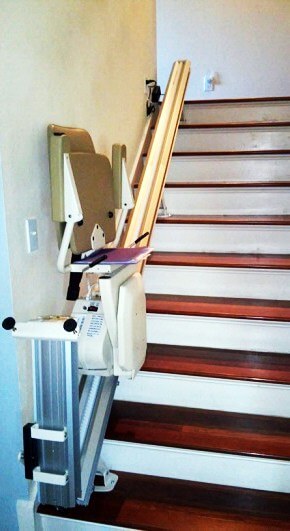 Stairlift folded up when not in use
Stairlift folded up when not in use
Stairlifts typically only take up about one to two feet of space on the staircase, depending on the make and model. When not in use, the seat bottom, armrests, and footrest can all be folded up to create even more space for others to use the stairs. Stairlifts also come with a call/send button that can be used to send the chair to a more convenient location at the top or bottom of the stairs when not in use.
My staircase is narrow – will the stairlift fit?
Modern homes are built with staircases that are plenty wide for stairlifts. However, if you have an older home, you may have a particularly narrow staircase. In these cases, the required width is determined based on the height of the individual who will be using the stairlift. To determine how much space you need, have the user sit in a standard kitchen chair and measure the distance from his back to his knees, then add about 12″ – this will tell you how much space is required to ensure that his knees are not hitting the wall while on the stairlift.
I only need a stairlift for a few months, can I rent one?
Many companies offer straight stairlifts for rental. They are a great option when you have a friend or relative visiting who needs assistance getting up the stairs, or while recovering from an injury. Rental options are usually very affordable, and ensure that individuals do not have to struggle with the stairs just because they have temporary needs. Unfortunately, custom stairlifts are not available for rental because they are custom-made to your staircase. In some situations, two straight units can be installed for rental use in split-level homes or staircases that have landings in the middle.
Will my insurance / Medicare pay for it?
Unfortunately, insurance and Medicare typically do not pay for stairlifts. However, many states do offer Medicaid waivers that will pay for stairlifts for qualifying individuals. For veterans, many VA facilities can provide either partial or full funding for the cost of home improvements related to accessibility. Additionally, if your doctor writes you a prescription for a stair lift, many states allow the seller to waive sales tax which can save you hundreds to thousands of dollars.
I’m interested in a stair lift! What do I do now?
It’s great that you’ve decided to move forward in making your home safe and accessible! Your next step will be to
research and contact local companies for quotes. While there are many companies that make and sell stairlifts, some of the most respected manufacturers in the industry are Bruno, Harmar, and HandiCare.
 A Home Consultation is usually the first step in getting a stairlift
A Home Consultation is usually the first step in getting a stairlift
Most of these companies sell through dealer networks that can install and service the equipment, rather than directly to consumers. Be sure to choose a reputable dealer that is local and uses only certified professional installers. Stairlifts are complex devices and should not be installed by general handymen. Some companies offer additional complimentary service warranties on top of the manufacturers’ warranties, which can save you a great deal of money, in the long run, should your stair lift have any issues.
Once you have done your research and read company reviews, you’ll likely need to schedule a consultation – any reputable company will offer this as a free first step so that they can assess your staircase and recommend only products best-suited for your specific needs. After the consultation, you should receive a written quote for the cost of the device as well as installation and any applicable terms. Never feel pressured to commit to a purchase right away – a stair lift is a big investment, and the Product Specialist should answer all of your questions and provide you all of the information you need to make a decision that makes you feel comfortable.
